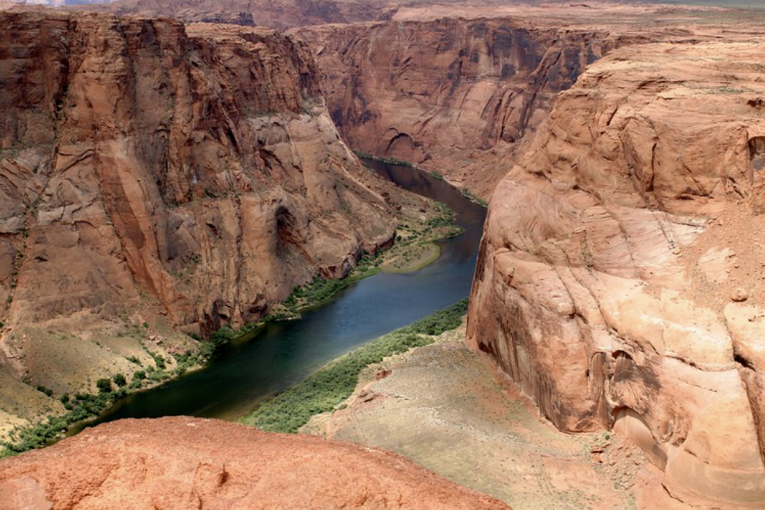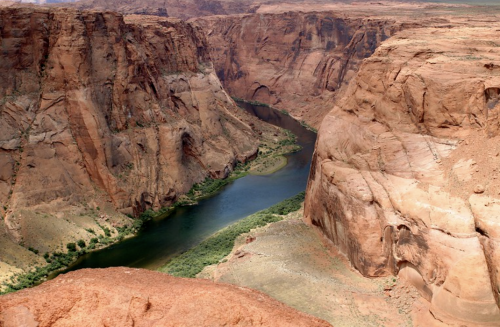
![]()

By Milo Feldman
On May 22nd, California, Nevada, and Arizona, and the Mohave, Chemehuevi, Hopi, and Navajo tribes reached an agreement to use less water from the Colorado River. These lower-basin states and tribes have agreed to collectively conserve three million acre-feet (MAF) of water, or thirteen percent of the total they receive, by 2023. At least 1.5 MAF must be conserved by the end of 2024.
So, how much water is that? It’s not super easy to visualize, but one acre-foot is about how much water two average households use in a year. According to Dr. Peter Gleick, a world-renowned water expert, one million acre-feet of water is about 1.6 times the annual water use of L.A.
The groundbreaking agreement, however, is more of an “agreement” to the “submission of a Lower Basin, consensus-based system conservation proposal,” according to the U.S. Department of the Interior press release. So it’s not quite time for celebration, as there are potential issues for this “agreement to agree” with. But it is certainly a step in the right direction.
This agreement, so to speak, comes after months of delayed response from the seven states (California, Nevada, Arizona, Colorado, New Mexico, Utah, and Wyoming) and four tribes (Mohave, Chemehuevi, Hopi, and Navajo) whose 40 million residents and members rely on the river’s water. The states were asked by the Interior Department to reach a concurrence by January 31, 2023, to reduce their overall consumption of the Colorado River water, on a scale never before seen in U.S. history given the severity of the situation.
The laws that determine the allocation of water between the states are over a century old. They are from the Colorado River Compact in 1922, which was based on a 17.5 million acre-feet flow per year, when the rate has actually averaged 15 million acre-feet per year since 1922. In the past few years, the average has dropped to 10 million acre-feet per year.
This agreement is a long time coming. We are consistently using more water than is naturally replenished from the ground, and on top of that, increasing temperatures and less frequent precipitation from climate change decrease replenishment. This has resulted in severe depletion of the water in Lake Mead and Lake Powell, the major reservoirs of the river.
The two major reservoirs of the river, Lake Mead, located on the border of Nevada and Arizona, and Lake Powell, located on the border between Utah and Arizona, provide water and electricity for Nevada, Arizona, and California, as well as some of Mexico. Upper-basin states like Wyoming, New Mexico, Colorado, and Utah get their water directly from the river.
The Southwest drought has lasted since 2000, which means that current UC Davis students who are mostly 18-22 years old cannot remember life or weren’t alive before the drought. That means they were raised to be very conscious of their water consumption — something that is pretty much unique to California and Southwest residents who are currently young Millennials or Gen Z.
Growing up in New York, I had summers of slip-and-slides, hose-water fights, and sprinkler showers on a lush green lawn. On the East Coast, summer is the wet season, and thunderstorms that canceled day camp happened fairly frequently. The air was humid, hot, and heavy, so a cool run through the hose water was a refreshing summer pastime.
I was never an irresponsible or obnoxious kid but I will say that I did enjoy plugging the shower drain and having “rain parties” with my stuffed animals for forty minutes to an hour. For all I knew, water was completely unlimited and magically appeared when you turned the knobs of the faucet.
On the other side of the country in Ceres, California, Virginia Moore, currently a second- year student at UC Davis, was taught explicitly about the importance of water conservation from a very young age. I’m sure her teacher would have used my rain parties as a perfect foil to the exemplary water-conscious Californian child.
This education has directly informed Moore’s mindset about water usage as she grew into a young adult. “I think because I was growing up around the time the California drought was a big deal, it was ingrained in me that water was a precious and finite resource,” she said.
“It’s kind of funny,” she says, “during sixth-grade camp, they only allowed us to take three-minute showers to save water, and all the kids in my class were like how the [heck] are we gonna do that and our teachers tried to hype us up about it before leaving for camp.”
But even though Moore’s teachers did a great job instilling the importance of frugality with water usage, the problem can’t quite be solved with three-minute showers (though that doesn’t excuse any forty-minute shower parties).
Residential water usage is not enough to make a substantial difference in water usage. In California, residential water usage is only 12 percent of the total freshwater used, and if the entire state of California took three-minute showers that might only put a dent in that twelve percent.
Agriculture is the vast majority of water usage at 79 percent and within that, 59 percent is livestock and twenty-four percent is crops. The rest of the water is for commercial and industrial use (four percent) and thermoelectric power (four percent). Clearly, it is not possible to reduce water limits enough by lowering residential use, and it’s actually the semi-scoffed-about “Meatless Mondays” that would have a much more significant role in reducing water.
One potential issue for this “agreement,” besides the fact that it would be consensus-based, which might it itself be a barrier to progress, is that it might focus too much on individual residential use instead of holding the agriculture industry accountable.
Doubling down on the education that Moore and other California residents remember from the past 20 years, is not a bad thing, but it is crucial to remember that (akin to climate-mitigation efforts that put the burden on individual actions — big oil creating the “carbon footprint”) the push to conserve water should be placed on industry, not individuals. It has never been a more important and perfect time to make changes to the American diet, but to have a significant impact on water consumption, that has to start from the industry level, not from individuals.
The next problem is the funding of it all. The agreement calls for the federal government to provide 1.2 billion dollars to irrigation districts and Indigenous tribes in the lower basin states to aid their water conservation efforts. While that seems like a good start, another space for trepidation is how the conservation of water might inevitably be unequally disastrous for the rural farming communities that rely on the water for their livelihoods, and might not have the luxury of other options.
It’s not a stretch to say that basically any shortage or drought is inevitably going to exacerbate disparity based on wealth and region. Fresh water is already not equally accessible across California, like the arsenic-laced water in the Oasis Mobile Home Park, home to almost entirely farmworkers who are priced out of moving away. Or that tribes, like the Ute Mountain Ute tribe with senior water rights have to battle for access through a series of water claim court decisions, and then do not have the funding for infrastructure that would allow them to access the water.
The efforts to conserve water over the next three years must firstly not only focus on individual residential action, but must make cuts to agriculture, specifically livestock, and must provide funding for the technology and infrastructure that would ensure that farmworkers and tribes across the Colorado River lower basin are not unequally effected by this agreement.
IMAGE DETAILS:
“Colorado River and Glen Canyon – Page, Arizona” by Jim Trodel https://www.flickr.com/photos/trodel/3598769444




